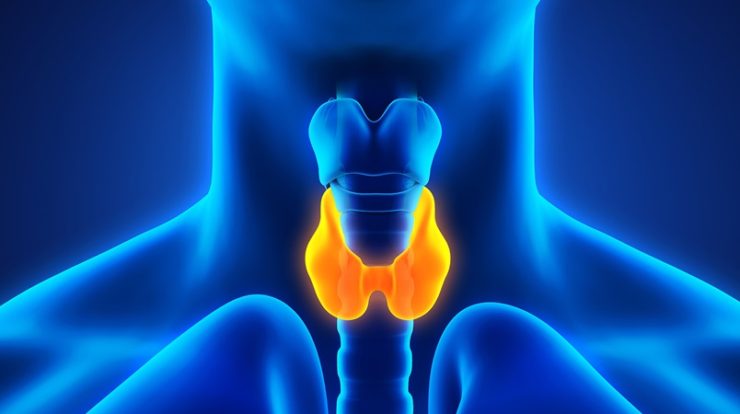
Thyroid cancer occurs in the cells of the thyroid — a butterfly-shaped gland located at the base of your neck, just below your Adam’s apple when cells change or mutate. The abnormal cells then begin multiplying in your thyroid and, once there are enough of them, they form a tumour.
If it’s caught early, thyroid cancer is one of the most treatable forms of cancer.
SYMPTOMS OF THYROID CANCER

It is common for people with thyroid cancer to have few or no symptoms. Thyroid cancers are often diagnosed by routine examination of the neck during a general physical exam. They are also unintentionally found by x-rays or other imaging scans that were performed for other reasons. People with thyroid cancer may experience the following symptoms or signs.
1. Trouble swallowing
2. Difficulty breathing that is sometimes compared to sucking air through a straw
3. Hoarseness or other voice changes
4. A constant cough that is not due to a cold
5. A lump in the front of the neck (around Adam’s apple) that might grow quickly
6. Swollen – but not painful — glands in the neck
7. Pain that starts in the front of the neck and goes up into your ears
Symptoms are not always a sign of thyroid cancer. A lump in your thyroid could be caused by an infection or a goitre, which is an abnormal growth of the thyroid gland. It might not be cancerous at all.
Your doctor will examine your thyroid during routine physical exams. If you have any symptoms between checkups, such as a new nodule on the gland or a rapidly growing one, you should make an appointment to have your thyroid gland checked.
TYPES OF THYROID CANCER

Thyroid cancer is classified into types based on the kinds of cells found in the tumour.
These include:
Papillary thyroid cancer
Found in up to 80% of all thyroid cancer cases, Papillary Thyroid cancer arises from follicular cells, which produce and store thyroid hormones. Papillary thyroid cancer can occur at any age, but most often it affects people ages 30 to 50. Doctors sometimes refer to papillary thyroid cancer and follicular thyroid cancer together as differentiated thyroid cancer. These cancers tend to grow very slowly and usually develop in only one lobe of the thyroid gland. Even though they grow slowly, papillary cancers often spread to the lymph nodes in the neck. But they can often be treated successfully and are rarely fatal.
Follicular thyroid cancer
Making up about 1 out of 10 thyroid cancer cases, Follicular thyroid cancer is more common in countries where people don’t get enough iodine in their diet. It arises from the follicular cells of the thyroid and usually affects people older than age 50.
Anaplastic thyroid cancer
Anaplastic carcinoma (also called undifferentiated carcinoma) is a rare form of thyroid cancer, making up about 2% of all thyroid cancers. This cancer is called undifferentiated because the cancer cells do not look very much like normal thyroid cells. This cancer often spreads quickly into the neck and to other parts of the body and is very hard to treat. Anaplastic thyroid cancer typically occurs in adults age 60 and older.
Medullary thyroid cancer
Accounting for about 4% of thyroid cancers, Medullary thyroid cancer begins in thyroid cells called C cells, which produce the hormone calcitonin. Elevated levels of calcitonin in the blood can indicate medullary thyroid cancer at a very early stage. Certain genetic syndromes increase the risk of medullary thyroid cancer, although this genetic link is uncommon.
Other rare types
Other very rare types of cancer that start in the thyroid include thyroid lymphoma, which begins in the immune system cells of the thyroid, and thyroid sarcoma, which begins in the connective tissue cells of the thyroid.
RISK FACTORS

Factors that may increase the risk of thyroid cancer include:
Female sex
Thyroid cancer occurs more often in women than in men.
Exposure to high levels of radiation
Radiation therapy treatments to the head and neck increase the risk of thyroid cancer.
Inherited genetic syndromes
Genetic syndromes that increase the risk of thyroid cancer include familial medullary thyroid cancer, multiple endocrine neoplasias, Cowden’s syndrome and familial adenomatous polyposis.
COMMON TREATMENT APPROACHES

Most thyroid cancers can be cured, especially if they have not spread to distant parts of the body. If cancer can’t be cured, the goal of treatment may be to remove or destroy as much of cancer as possible and to keep it from growing, spreading, or returning for as long as possible.
Some common treatment procedures are:
1. Surgery
Surgery is the main treatment in nearly every case of thyroid cancer, except for some anaplastic thyroid cancers. If thyroid cancer is diagnosed by a fine needle aspiration (FNA) biopsy, surgery to remove the tumour and all or part of the remaining thyroid gland is usually recommended.
2. Radioactive Iodine Ablation
The thyroid gland and most thyroid cancers absorb iodine. Radioactive iodine (RAI) ablation is used to destroy any thyroid tissue that’s left after a thyroidectomy. The iodine goes to the thyroid tissue and the radiation destroys it. The level of radiation in this treatment is far higher than what is used in a radioiodine scan.
This treatment can be used to ablate (destroy) any thyroid tissue not removed by surgery or to treat some types of thyroid cancer that have spread to lymph nodes and other parts of the body.
3. Thyroid Hormone Therapy
If all of your thyroid gland was removed (thyroidectomy), your body can no longer make the thyroid hormone it needs. You will need to take thyroid hormone (levothyroxine) pills to replace the natural hormone and help maintain normal metabolism. The pills also help stop leftover cancer cells from growing and returning. They do this by lowering the level of thyroid-stimulating hormone (TSH), lowering the risk of cancer coming back.
4. External Beam Radiation Therapy
External beam radiation therapy uses high-energy rays to destroy cancer cells or slow their growth. A carefully focused beam of radiation is delivered from a machine outside the body.
This type of radiation therapy is most often used to treat medullary thyroid cancer and anaplastic thyroid cancer. It is used for cancers that don’t take up iodine and spread beyond the thyroid. External beam radiation therapy might be done to help treat cancer or to lower the chance of cancer coming back in the neck after surgery.
5. Chemotherapy
Chemotherapy is seldom helpful for most types of thyroid cancer, but fortunately, it is not needed in most cases. It is often combined with external beam radiation therapy for anaplastic thyroid cancer and is sometimes used for other advanced cancers that no longer respond to other treatments.
Don’t fret of the disease. Fight it with courage, hope and faith. When you’re eating a healthful diet, getting enough exercise, managing stress, and getting enough sleep, you’ll know you’re doing everything you can to fight the disease.
About The Author
Pavtan Food Products have been made after years of scientific research based on Ayurveda and Medical Science.
Our ‘Cancer Care Aata’ has proved to be an ayurvedic gift to cancer patients, thousands of them have benefitted from it. The major ingredients include Raj Gira, Singhada, Saava, Kattu and Moong which help in curing cancer and preventing the cancer cells to grow further.
To know more, click here https://www.pavtan.com/pavtan-cancer-care-aata
